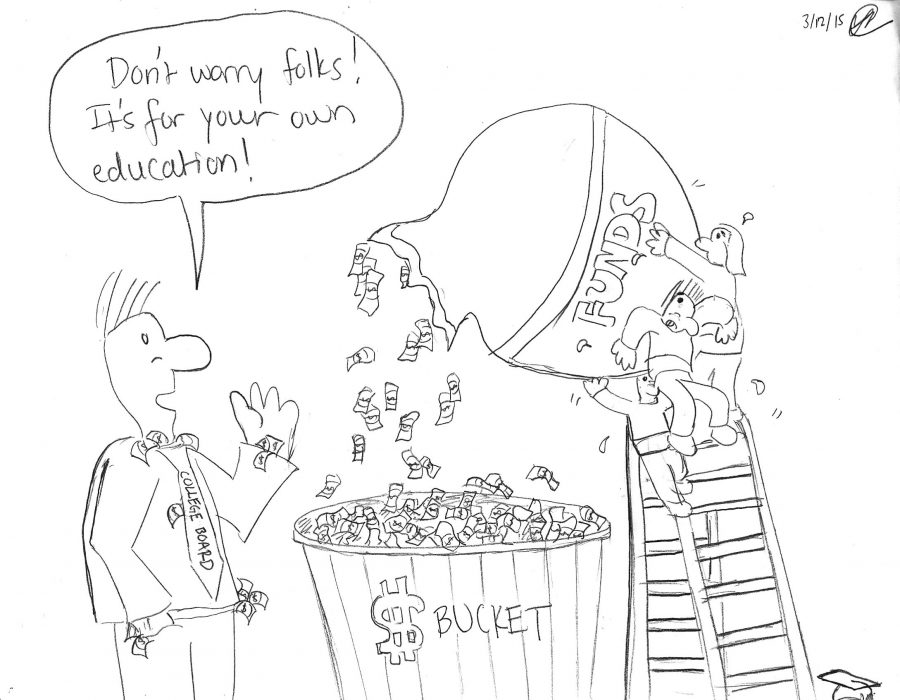
By EMMA HSU
Staff Writer
The College Board: well-known across the world of education and very well-known here at University High School (UHS). Most college entry standardized testing, score reporting and sending is done through the College Board. It is essentially an indispensable part of most college application processes and, thus, reaches numerous students at UHS.
thAccording to its website, the College Board is composed of “more than 6,000” educational institutions around the world” and “helps more than seven million students prepare for a successful transition to college through programs and services in college readiness and college success.” Indeed, this vast number of institutions and students is quite astounding. The College Board reaches students, mostly 10
ththrough 12
grade, of all ethnicities and economic backgrounds.
The Washington PostWith this wide grasp on the student population, however, also comes the concern that the College Board has a huge monopoly over the standardized testing industry. Its only other main competitor is the ACT, and even though
reports that the number of SAT test takers have declined, while the number of ACT test takers has risen over the last seven years, the College Board continues to have a strong hold on the industry. This monopoly gives the College Board the power to exploit consumers and raise prices whenever it desires.
Bloomberg Business,According to their website, the College Board claims to be a “not-for-profit membership organization committed to excellence and equity in education.” The term “not for profit,” however, does not seem to be correct. According to
the CEO of the College Board reportedly makes more than $1 million each year, and “nineteen executives at the New York-based College Board get more than $300,000 per year.” These salaries sound fitting for a business corporation, not a nonprofit organization. Its exorbitant revenues, along with its tax exempt status as a nonprofit organization, make the College Board a questionable organization.
All this money comes from the fees charged for nearly every service the College Board offers. Except for the SAT, the College Board has a complete monopoly over its other resources, including Advanced Placement (AP) testing, SAT Subject tests, the College Scholarship Service (CSS) — a scholarship service profile which ironically requires a fee — and the Preliminary SAT (PSAT). With each service comes a price tag and not a small one.
Take, for example, the average student. She takes the SAT, which is required by most colleges, for $52. Then add two Subject Tests at $58. Then, with the College Board’s monthly reminders that retaking the tests might possibly yield higher scores, she retakes the SAT two more times and the Subject Tests each one more time, equaling to $272 spent so far. She then sends her scores to 8 different colleges with each score report costing $11.25, in all totaling $90. Her new total now at $362. In her whole high school career, she takes, say, five AP courses. Each AP test is $100 — which, in all seriousness, $100 seems to be too much to administer one test. With five, the total is $500. In all, your average student has paid the College Board $862.
With that being said, keep in mind that many students take more tests than our hypothetical student has taken. Multiply the testing expenditures of a single student by the millions of students in the world who take these tests, and it is obvious that there is a huge profit margin. According to the National Association of Independent Colleges and Universities (NAICU), in 2006, College Board had $582.9 million of revenue but spent only $527.8 million, leaving a $55.1 million surplus. Since the demand for high test scores will only keep growing, the College Board can easily manipulate prices and make an even more outrageous profit.
These past years have also seen a rise in preparatory academies, helping students prepare for standardized tests by drilling them with methods and formulas to do well on tests. Many of these prep schools cost hundreds or thousands of dollars. Nearby Elite Educational Institute costs $2,300, and has been integrated into the lives of UHS students so much that it is not uncommon to hear students use Elite as a reference point of location instead of street names. Again, the demand for high test scores is ever increasing, and, thus, so is the number of preparatory academies. Not everyone, however, can afford to attend SAT boot camps. This hike in preparatory academies puts low income students at a disadvantage in testing and, ultimately, in college admissions.
It sure seems that the more money spent on standardized testing, the better the chances of receiving a high score. People who spend more money on preparing for the tests and retaking the tests have a higher likelihood to do well. This focus on money promotes inequality among students around the world, giving an unfair advantage to students who already come from affluent households. Although the College Board does offer some fee waivers, the money is not nearly enough to give students from low income households the leisure to repeatedly retake tests and attend preparatory classes. So despite the College Board’s goal to promote “equity in education,” its money-making techniques and formulaic tests ironically undermine this idea.
I have only addressed the College Board’s incongruities because the College Board has the biggest reach over its industry. However, the ACT and Educational Testing Service (ETS) are equally as unjust as the College Board is. These “nonprofit” organizations are all run like big businesses, and all make huge profits every year. They are clearly in the industry for the money, and their mission statements and views are blatant lies. So, before you sign up for the next SAT or AP test, ask yourself if you are fully prepared. Otherwise, aside from sitting through a dreadful test, you will simultaneously be supporting a lying, greedy corporation.















Kelly • Mar 18, 2015 at 8:27 pm
YES! That is completely true.